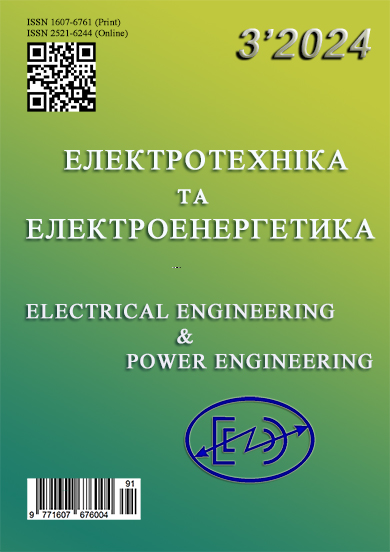Pulse current stabilizer with digital control for the power supply system of the plasmatron
DOI:
https://doi.org/10.15588/1607-6761-2024-3-2Keywords:
pulse current stabilizer, digital control circuit, duration of the transition process, esired transfer function, simulation model, synthesis, astatism, reference transient characteristicAbstract
Purpose. Solution of theoretical and practical problems on providing digital control of a pulse converter using high-speed microprocessor tools in the output current stabilization mode with provision of a specified duration of transient processes caused by an increase in load voltage and output current astaticity, which allows to obtain significant advantages over analog versions.
Methodology. Review of literary and patent sources on the subject, theory of pulse automatic control systems, mathematical modeling of processes in pulse current stabilizers in the MATLAB / Simulink software environment and physical prototyping.
Findings. A simulation model of an autonomous power supply system based on a converter using soft switching technology of transistors and an arc load is presented. A control law is synthesized and a model of a pulse current stabilizer is developed. A method is proposed and ways are found to control a pulse current stabilizer that provide a given duration of transients and astatism of the output current. A model of a pulse stabilizer with digital control based on a single-crystal computing module is developed and manufactured. The results of the study confirm the achievement of a finite duration of transient processes caused by a step change in the load voltage, close to 3-4 periods of conversion and output current astaticism. It is shown that the use of a pulse stabilizer using a fully digital control circuit has undeniable advantages over analog systems.
Originality. The problem of synthesizing a digital controller for a given control time by the method of desired transfer functions for a soft switching operating converter on an arc load is solved. In addition to the given control time, additional quality requirements in the steady state are provided.
Practical value.The use of microprocessor technology makes it possible not only to implement complex and new highly efficient control algorithms for a converter operating in the pulse current stabilizer mode, but also to perform additional functions for overload protection, self-diagnostics and telemetry of pulse converters. The use of this same digital device simultaneously for the purpose of controlling a pulse converter will allow to abandon analog PWM controllers and thereby reduce its own energy consumption and weight and size characteristics, increase the reliability of the functioning of pulse converters in power supply systems as a whole.
References
Kuo B. Theory and Design of Digital Control Systems: Trans. from English. Moscow: Mashinostroenie, 1986, 448 p.
Bessekersky V.A., Popov E.P. Theory of Automatic Control Systems. St. Petersburg: Profession, 2003. 700 p.
Kim D.P. Theory of Automatic Control. Vol. 1. Linear Systems. Second ed., corrected and supplemented. Moscow: FIZMATLIT, 2007, 304 p.
Krotenko V.V. Parametric Synthesis of Digital Control Systems with Transistor Pulse-Width Converters // News of the Universities of Instrument Engineering. 2003. Vol. 46. No. 6. P. 25-31.
Izerman R. Digital Control Systems. Moscow: Mir, 1984, 460 p.
Silva G.J., Datta A., Bhattacharyya S.P. PID Controllers for Time-Delay Systems. Boston: Birkhauser. 2005. 330 p.
Gu Da-Wie,. Petkov P.Hr,. Konstantinov M.M. Robust Control Design with MATLAB. Springer-Verlag. 2005. 390 p.
Krutko P.D. Inverse problems of dynamics of controlled systems: Linear models. Moscow: Nauka, 1987. 304 p.
Jang Y., Jovanovic M. A new PWM ZVS full-bridge converter. / IEEE Transactions on Power Electronics. – 2007. – Vol. 22 (3). – P. 987-994. https://doi.org/10.1109/TPEL.2007.897008
Yang B., Duarte J., Li W., Yin K., He X., Deng Y. Phase-shifted full bridge converter featuring ZVS over the full load range. / IECON 2010 – 36th Annual Conference on IEEE Industrial Electronics Society, 2010. – Pp. 644-649.
Ilchmann A., Eugene P. Ryan E. High-gain control without identification: a survey. / GAMM-Mitteilungen. – 2008. – Vol. 31(1). P. 115 – 125. https://doi.org/10.1002/gamm.200890000
Minimum Time Control for Multiphase Buck Converter: Analysis and Application / Cheng P., Vasic M., Garcia O., Oliver J.A., Alou P., Cobos J.A. // IEEE Transactions on Power Electronics. 2014. Vol. 29, Issue 2. Pp. 958 – 967. https://doi.org/10.1109/TPEL.2013.2256798
Zhao Z., Prodic A. Continuous-Time Digital Controller for High-Frequency DC-DC converters. / IEEE Transactions on Power Electronics, vol. 23, no. 2 March 2008, pp. 564-573.
Analysis of a direct current converter operating on a plasma arc. / E.M. Vereshchago, V.I. Kostiuchenko, S.M. Novogretsky // Electrical engineering and electromechanics, 2023, No. 5, 31–36. https://doi.org/10.20998/2074-272X.2023.5.05
Synthesis of a Control System of a Pulse Converter for Plasmatron Power Supply / E. Vereshchago, V. Kostiuchenko, Y. Stohniienko // 2023 IEEE 4th KhPI Week on Advanced Technology (KhPIWeek). P.394-397. https://doi.org/10.1109/KhPIWeek61412.2023.10312905
Digital Control System of a Pulsed Power Supply for the Plasmatro / E. Vereshchago, V. Kostiuchenko, S. Novogretskyi // 2023 IEEE 5th International Conference on Modern Electrical and Energy System (MEES). P.30-34. https://doi.org/10.1109/MEES61502.2023.10402495
Downloads
Published
How to Cite
Issue
Section
License
Copyright (c) 2024 E.M. Vereshchago, V.I. Kostiuchenko

This work is licensed under a Creative Commons Attribution-ShareAlike 4.0 International License.
Creative Commons Licensing Notifications in the Copyright Notices
Authors who publish with this journal agree to the following terms:
Authors retain copyright and grant the journal right of first publication with the work simultaneously licensed under aCreative Commons Attribution License that allows others to share the work with an acknowledgement of the work's authorship and initial publication in this journal.
Authors are able to enter into separate, additional contractual arrangements for the non-exclusive distribution of the journal's published version of the work (e.g., post it to an institutional repository or publish it in a book), with an acknowledgement of its initial publication in this journal.
Authors are permitted and encouraged to post their work online (e.g., in institutional repositories or on their website) prior to and during the submission process, as it can lead to productive exchanges, as well as earlier and greater citation of published work.

